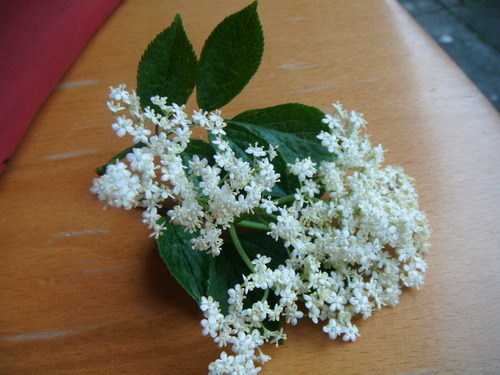Elderflower is in season from end of May to June.

When I was satisfied it was the right plant, I sourced some right by my house, not near the road and headed to the shop to buy sugar and lemons for the brew.
I adapted this recipe from my ever-loved River Cottage show. The recipe admits that it sometimes causes "collateral damage", i.e. exploding bottles, but this can be totally avoided by leaving the brew for three weeks before bottling, as opposed to six days as directed by the recipe.
For once I could justify the collection of odds and ends at the side of the house, and pulled out a perfect bucket. I gave it a good soaking and cleaning, killing one little spider in my path (sorry little spider, I didn’t see you in time).
ELDERFLOWER CHAMPAGNE
Ingredients
3 litres of water (2l boiling, 1l cold)
350g sugar
Juice and zest of three small lemons
Tablespoon of white wine vinegar
About 20 Elderflower heads

Directions:
Collect your elderflowers on a sunny day, preferably in the evening, when the scent and natural yeast in the flowers is at it's most potent.
Pick the best blooms, with mostly open flowers.
Give the elderflower a good shake to remove any insects but don't wash it. Using a scissors, remove as much of the green stem as possible.
Put the sugar into the bin.
Add the boiling water and stir with a clean, sterilised spoon to dissolve.
Add the cold water, lemon juice and vinegar.
Allow the mix to cool and then add the elderflower.
**Photo from another batch** showing the mix:

It's not much to look at now, at all but after three weeks covered with a clean muslin cloth and sitting in a cool, dark place the mix is darkened and frothy and smells gorgeous:

There may be some mould on top but that is no problem.
BOTTLING
You will need:
1 glass
1 measuring jug
A few squares of muslin
Empty clean bottles to make up 3 litres. I prefer simple plastic screw top bottles as you can open them slowly, thus avoiding blasting the liquid everywhere. However, if you want that effect use swing top glass bottles for a show stopping opening!
Fill your glass from the bucket. You will have a mix of liquid and flowers:
Cover the measuring jug with a piece of clean muslin and pour in the contents of the glass. The weight of the wet flowers may drag down the muslin so try to keep it taut:
Discard the spent flowers from the muslin before each fill.
Here is the filtered champagne ready for bottling:
Prime each bottle with a teaspoon of sugar before filling with liquid.
Ta da!
Leave the bottles to sit for a few days. It you squeeze the sides you will feel the pressure that has built up. It is now time to open and enjoy!
It's so simple. Do it.




No comments:
Post a Comment
I'd love to hear your comments...if only to know that someone is reading this blog!